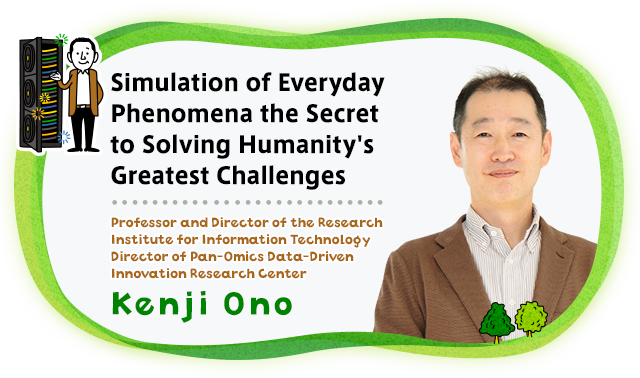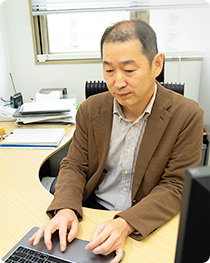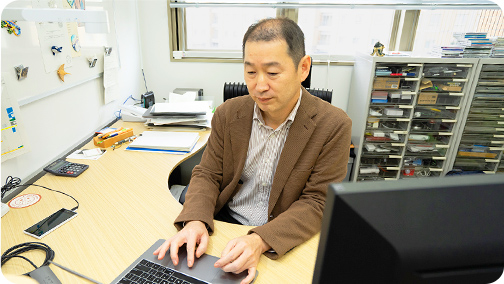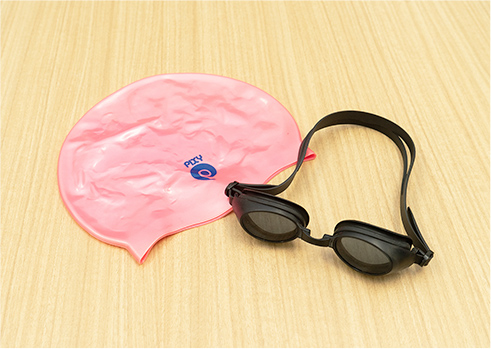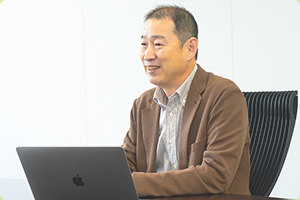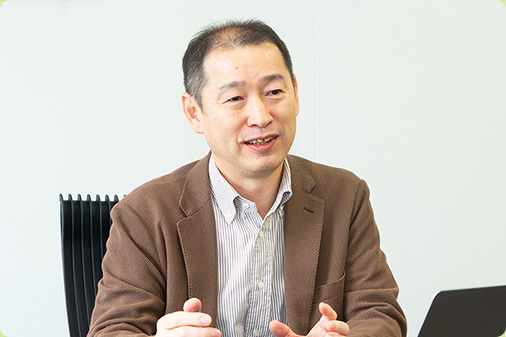 Prof. Ono explains his research in a calm and metered tone using plenty of illustrative examples.
Prof. Ono explains his research in a calm and metered tone using plenty of illustrative examples.
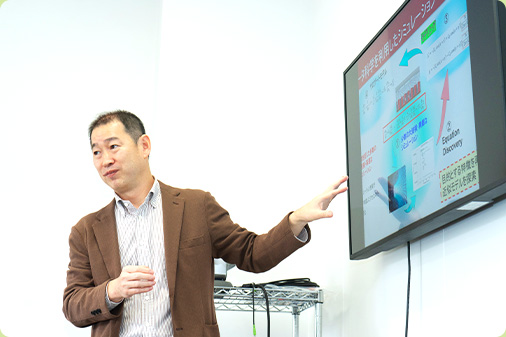 A simulation of human breathing that includes a visualization of the eddies in the air caused when people breathe out of their nostrils.
A simulation of human breathing that includes a visualization of the eddies in the air caused when people breathe out of their nostrils.
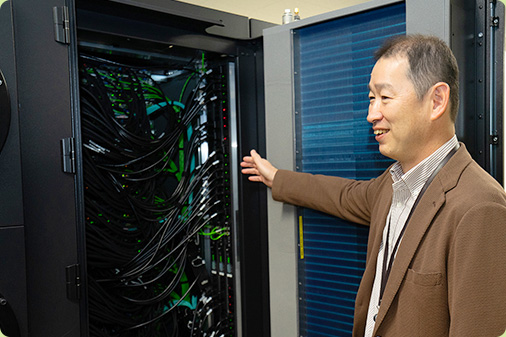 Supercomputer system ITO supports the field of data science at Kyushu University. Prof. Ono had a hand in designing it and made sure that it was flexible enough to be used in data science research.
Supercomputer system ITO supports the field of data science at Kyushu University. Prof. Ono had a hand in designing it and made sure that it was flexible enough to be used in data science research.
 Prof. Ono explains his research in a calm and metered tone using plenty of illustrative examples.
Prof. Ono explains his research in a calm and metered tone using plenty of illustrative examples.
I can describe my research in three words: fluids, supercomputers, and visualization. Fluids, in a word, means vortexes. There are many different kinds of vortexes, from the giant spirals of typhoons to the microscopic eddies that form above the wings of an airplane. I use a supercomputer to analyze these vortexes and simulate a variety of phenomena. To understand what is really happening, however, visualizations are vital. By turning data into a picture that people can see and understand, it becomes possible to explain it, improve it, and apply it to other fields.
 A simulation of human breathing that includes a visualization of the eddies in the air caused when people breathe out of their nostrils.
A simulation of human breathing that includes a visualization of the eddies in the air caused when people breathe out of their nostrils.
When I graduated from university and started work at a company, my very first task was to simulate the air resistance of automobiles. Numerous experiments are carried out when designing an automobile, but it would be extremely costly and time-consuming if for every experiment a car had to be built and physically tested. That's when you need to start using simulation technology. The more sophisticated something becomes, the larger the computations. That's why we use supercomputers to solve them. If you've noticed that weather forecasts seem more accurate now than they were in the past, it's because the accuracy of computer-generated numerical simulations has increased.
 Supercomputer system ITO supports the field of data science at Kyushu University. Prof. Ono had a hand in designing it and made sure that it was flexible enough to be used in data science research.
Supercomputer system ITO supports the field of data science at Kyushu University. Prof. Ono had a hand in designing it and made sure that it was flexible enough to be used in data science research.
My research changes so much, you could almost say it’s fluid! [laughs] But I am currently concentrating on the topic of physical modeling, which integrates data science and high-performance computing (HPC). Traditionally, researchers would take a deductive approach to the problem by first running a simulation of a basic equation on a supercomputer, then running data analyses and visualization before finally understanding a phenomenon. My recent research, however, uses an inductive method, where the governing equations themselves are derived from vast amounts of data using HPC, through a repetitive cycle of modeling, simulation, and reconsideration of equations, followed by additional re-modeling, re-simulation, and so on. In this way, I strive to explore new interpretations of phenomena and the governing equations for phenomena that we have yet to understand. This work requires interdisciplinary coordination and knowledge from a broad range of academic disciplines that include not only data science but also physics, dynamics, and others.
These days, areas of advanced academic research require collaboration between researchers, each contributing their own expertise. Now is a time when researchers must work together to find solutions to the problems facing humanity, problems that have until now been unsolvable. At Kyushu University, for example, the Pan-Omics Data-Driven Innovation Research Center is a joint research facility established in 2019 and shared by the five institutes of the Medical Institute of Bioregulation, Research Institute for Applied Mechanics, Institute for Materials Chemistry and Engineering, Institute of Mathematics for Industry, and Research Institute for Information Technology.


I am happiest when I’m surprised by a discovery. That’s why I love what I do. The visualizations I make are fun to look at and are an integral part of fluid mechanics. Especially the behavior of fluids, which are so fascinating to me— I never get tired of looking at them. It is quite calming.
Discoveries do not appear out of nowhere. I'm constantly thinking about the problems and, perhaps on a subconscious level, am always on the lookout for clues, and that's when inspiration strikes. I will then make a hypothesis about my discovery and use simulations to verify its accuracy. Visualizations are at the root of my inspiration. Sometimes I even hit upon a hypothesis just by looking at one. I find the process of creating ideas and discoveries from many different approaches, then verifying each of them, very interesting.
The field of fluid dynamics is actually a very relatable one. It's fascinating the extent to which cutting-edge computer technologies are connected to the human mind. And there are many opportunities to work with researchers across various fields where we are able to bring out the potential in each other's work.

![]()




